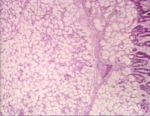Difference between revisions of "Adenoma"
Jump to navigation
Jump to search
| Line 12: | Line 12: | ||
| + | ==Tumours of the Perianal Area== | ||
| + | ===Hepatoid Gland Tumours (Perianal Adenomas)=== | ||
| + | [[Image:normal perianal gland.jpg|thumb|right|100px|Perianal gland- normal (Courtesy of Bristol BioMed Image Archive)]] * Affect the dog. | ||
| + | * Arise from the solid, modified sebaceous circumanal glands. | ||
| + | * Common in ageing entire males. [[Image:perianal gland adenoma histopath.jpg|thumb|100px|Perianal gland- adenoma (Courtesy of Bristol BioMed Image Archive)]] | ||
| + | |||
| + | * Lesions range from hyperplasia to true adenomas (benign). | ||
| + | ** These low grade lesions are under hormonal control. | ||
| + | *** Castration/ administation of oestrogens or anti-androgens causes reduction in size.[[Image:perianal gland adenoma.jpg|thumb|right|100px|Perianal adenoma- gross appearance (Courtesy of Bristol BioMed Image Archive)]] | ||
| + | * Occasionally hepatoid carcinomas (malignant) arise in affected males | ||
| + | ** Outwith hormonal control. | ||
| + | * Hepatoid gland tumours occur rarely in bitches. | ||
| + | ** Are commonly malignant. | ||
| + | * Hepatoid glands are also found at the tail head, prepuce and occasionally other skin sites. | ||
| + | ** Hepatoid tumours can also arise in these areas. | ||
Revision as of 19:41, 6 June 2010
- Adenomas are unusual but may develop in oropharyngeal salivary tissue.
Intestinal adenoma
- An adenoma is a growth of glandular origin.
- Intestinal adenomas are found in both the small and large intestines.
- Intestinal adenomas usually grow into the lumen.
- These growths are bengin and polyp-like.
Tumours of the Perianal Area
Hepatoid Gland Tumours (Perianal Adenomas)
* Affect the dog.
- Arise from the solid, modified sebaceous circumanal glands.
- Common in ageing entire males.
- Lesions range from hyperplasia to true adenomas (benign).
- These low grade lesions are under hormonal control.
- Castration/ administation of oestrogens or anti-androgens causes reduction in size.
- These low grade lesions are under hormonal control.
- Occasionally hepatoid carcinomas (malignant) arise in affected males
- Outwith hormonal control.
- Hepatoid gland tumours occur rarely in bitches.
- Are commonly malignant.
- Hepatoid glands are also found at the tail head, prepuce and occasionally other skin sites.
- Hepatoid tumours can also arise in these areas.




